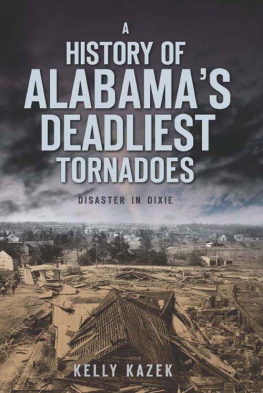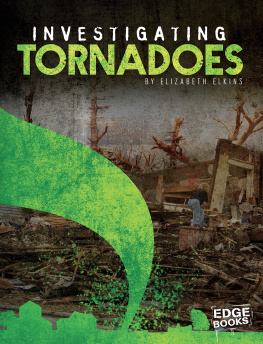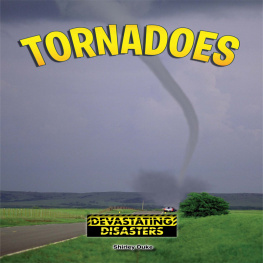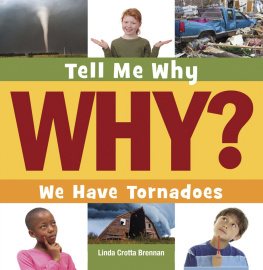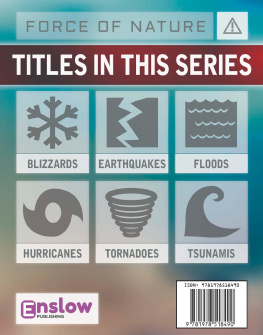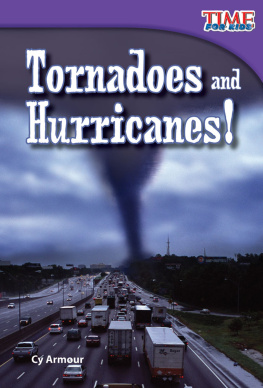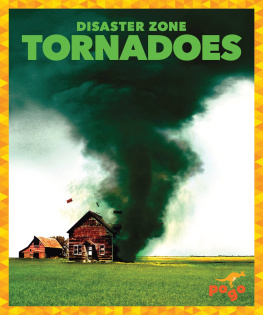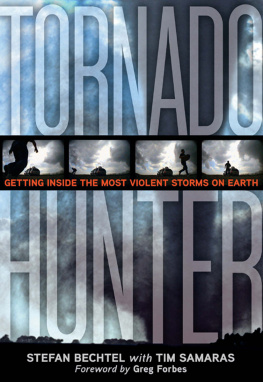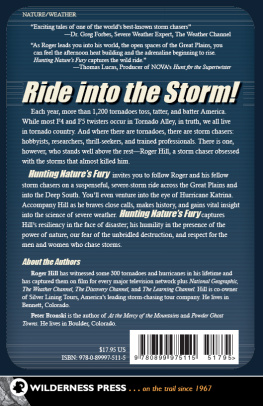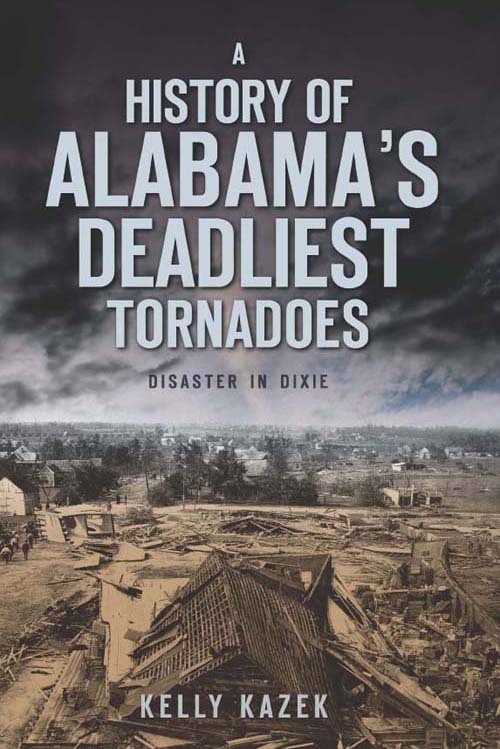A
HISTORY OF
ALABAMA'S
DEADLIEST
TORNADOES
DISASTER IN DIXIE
A
HISTORY OF
ALABAMA'S
DEADLIEST
TORNADOES
DISASTER IN DIXIE
KELLY KAZEK

Published by The History Press
Charleston, SC 29403
www.historypress.net
Copyright 2010 by Kelly Kazek
All rights reserved
First published 2010
e-book edition 2011
ISBN 978.1.61423.169.1
Kazek, Kelly.
A history of Alabama's deadliest tornadoes: disaster in Dixie/Kelly Kazek.
p. cm.
Includes bibliographical references.
print edition ISBN 978-1-59629-911-5
1. Alabama--History--Anecdotes. 2. Tornadoes--Alabama--History--Anecdotes. 3. Disaster victims--Alabama--Biography--Anecdotes. 4. Alabama--Biography--Anecdotes. 5. Birmingham Region (Ala.)--History--Anecdotes. 6. Huntsville Region (Ala.)--History--Anecdotes. I. Title.
F326.6.K39 2010
976.1--dc22
2010014770
Notice: The information in this book is true and complete to the best of our knowledge. It is offered without guarantee on the part of the author or The History Press. The author and The History Press disclaim all liability in connection with the use of this book.
All rights reserved. No part of this book may be reproduced or transmitted in any form whatsoever without prior written permission from the publisher except in the case of brief quotations embodied in critical articles and reviews.
This book is dedicated to those people whose stories are told on the following pages: the victims, survivors and heroes of Alabama's deadliest tornadoes, and to the meteorologists who work toward a better understanding of these powerful storms.
And to my grandmother, Shannon Blackburn Gray, whose words inspired me.
Contents
A CKNOWLEDGEMENTS
No book is ever written without help, but a book chronicling the impact of disaster on people's lives requires the assistance of many people.
While this book focuses mostly on personal stories and the aftermath of deadly tornadoes, I did spend some time learning about tornadoes in general, as well as the specific tornado incidents described on these pages.
I must thank those scientists whose goal is to learn more about tornadoes in an effort to save lives and who shared some of their vast knowledge with me: J.B. Elliott, who is retired from the National Weather Service in Birmingham but still keeps an eye toward the skies; Dave Nadler with the National Weather Service in Huntsville, who kindly invited me to visit the facilities; John DeBlock with the National Weather Service in Birmingham; and the staff of Limestone County Emergency Management AgencyRita Wilson, Daphne Ellison and Spencer Black.
Thanks to those who were kind enough to give permission to use the incredible photos of tornado damage, family members or monuments to victims: Bill Wilson of the Anniston Star (various), Jim Pemberton (1989), Limestone County EMA (1974), the family of the late Larry Waldrup/Waldrup Studios in Huntsville (1974), the City of Guin (1974), Dennis Burgess and the Albertville Historical Society (1908), Johnie Parker (1924), Analiese Schell (1932), J.B. Elliott (1977), Walter Kirkwood (1998) and the Reverends Dale and Kelly Clem (1994).
The inset photo on the back cover does not depict any of the storms that follow on these pages, but it is a tornado that struck Alabama. This storm hit the Five Points community in January 2010, just as I was completing this project. While several homes were damaged, including that of a close friend, no one was injured. Thanks to Brandon Cripps for the amazing photo.
I also appreciate those who took photos specifically for inclusion in this book: Melanie Flanagan Elliott and Kim Rynders of the News Courier.
This book could not have been completed without the personal interviews and family and historical documents shared by the following: Dennis Burgess (1908); J.T. Collins and Johnie Parker (1924); Analiese Schell and Ray Atchison (1932); Sue Hilton Sellers and Elizabeth Sheetz (1956); Sandra Birdwell, Ananias Green, Donnie and Felica Powers, Faye McElyea, Walter McGlocklin, Marilyn McBay, Mike Kelley and Tom Griffis (1974); J.B. Elliot (1977); Kathy and Johnny Sharp, Fred and Mona Keith, Scott Gilbert, Shannon Dickinson, Jeff Scarborough, Marcia Scarborough Keller, Bridget McGary Sanders, Suzanne Keller, Tara Alt Brown and Jennifer Cosby (1989); the Reverends Dale and Kelly Clem (1994); Doris and Walter Kirkwood Sr., Terry Hyche, Jimmy Massey, H.G. Hootie Shoemaker, Walter Kirkwood Jr. and Brian McKay (1998).
I send great big hugs to my good friends who had the difficult task of being supportive as I wrote this book, as well as reading the manuscript and offering input: Michael and Melanie Flanagan Elliott, Sabrina Holt, Traci Parker, Cynthia Carpenter Slayton, Charlotte Fulton, Kim Rynders and Jean Cole.
I salute my commissioning editor, Will McKay, who has abundant patience.
Thanks to my family for the encouragement, particularly my brother and sister-in-law Kevin and Susan Caldwell.
Lastly, thanks to my baby, Shannon, who had to put up with my moods when writing on a deadline. Love ya, babe. Mean it!
I NTRODUCTION
Not long after dawn broke on the morning of November 16, 1989, I was drawn to the intersection of South Memorial Parkway and Airport Road in Huntsville, Alabama.
I used my relatively new press pass to get past the armed National Guard soldier stationed at the head of Airport Road, although I was not there as a reporter that day. I was there to bear witness to one of the most catastrophic events to hit this middle-class area of Alabama's fourth largest city.
The streets of south Huntsville were ones I had driven many timeson which, in fact, I had learned to drive. The sites along Airport Road were familiar ones. I'd shopped at the jewelry counter at Golbro and bought Cokes at Riley's Food Store.
But on this day, it was difficult to get my bearings. The landmarks of my youth were gone. In their place were piles of lumber and twisted metal. In the days following the horrific F4 tornado of November 15, 1989, almost everyone interviewed would liken Airport Road to a war zone.
It had become clich for tornado damage sites, but it was accurate nonetheless. In the span of a few minutes, churches and schools were destroyed, an apartment complex was reduced to rubble and more than one hundred cars were tossed into heaps like toys; 21 people were dead and 263 more were injured.
It would be many years before Huntsville would recover.
I had been a newspaper reporter for about two years, and it was the first time I had witnessed the aftermath of such wrath. It would not be the last.
Over the course of the next twenty-one years, I would bear witness to countless tragedies, both natural and man-made: a teen murdered by her father, children killed in car crashes, a woman drowned after falling from the Tennessee River Bridge.
I would photograph the Gulf Shore after it was devastated by Hurricane Ivan and make three trips to the coasts of Alabama and Mississippi to record Katrina's impact. They are images I will not ever forget.
Some people think that reporters become cold, insensitive to the impact of tragedy. The reality, though, is often different.
On the outside, we journalists must remain coolly objective in order to get the facts of a story. But on the inside burns the desire to record the human storiesperhaps in the hopes that history won't repeat, or to remind readers that the impact of tragedy continues long after camera crews have left or maybe just so that future generations will have a chance to know a person who no longer walks among us.

